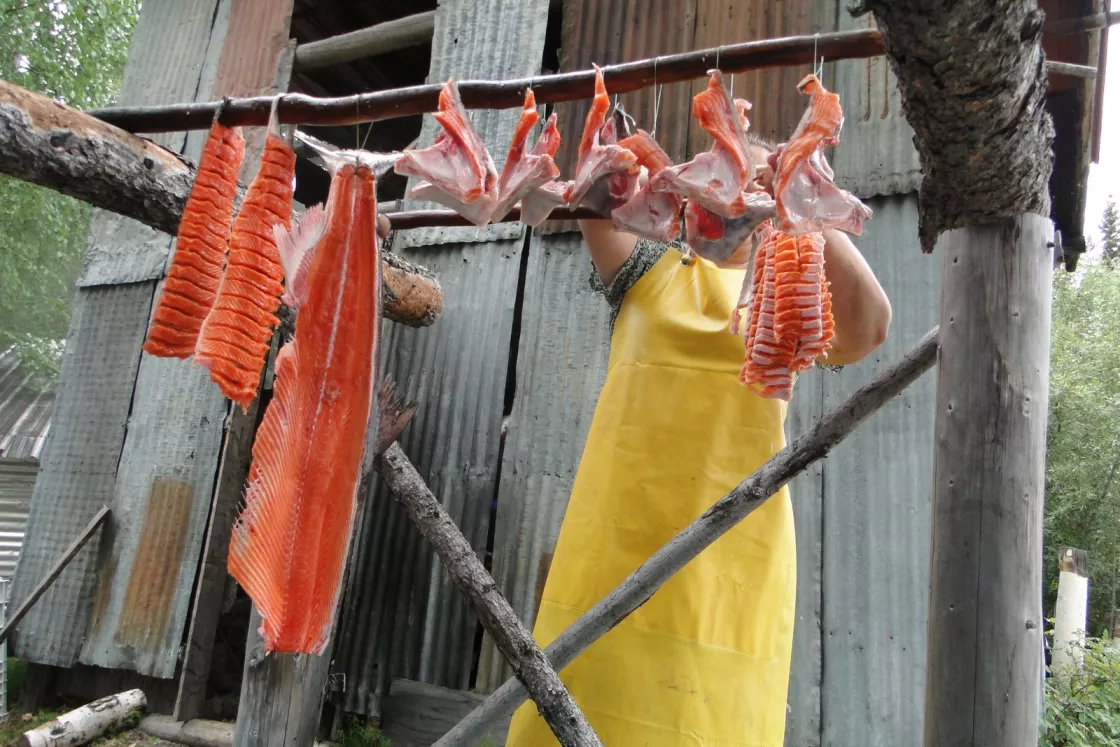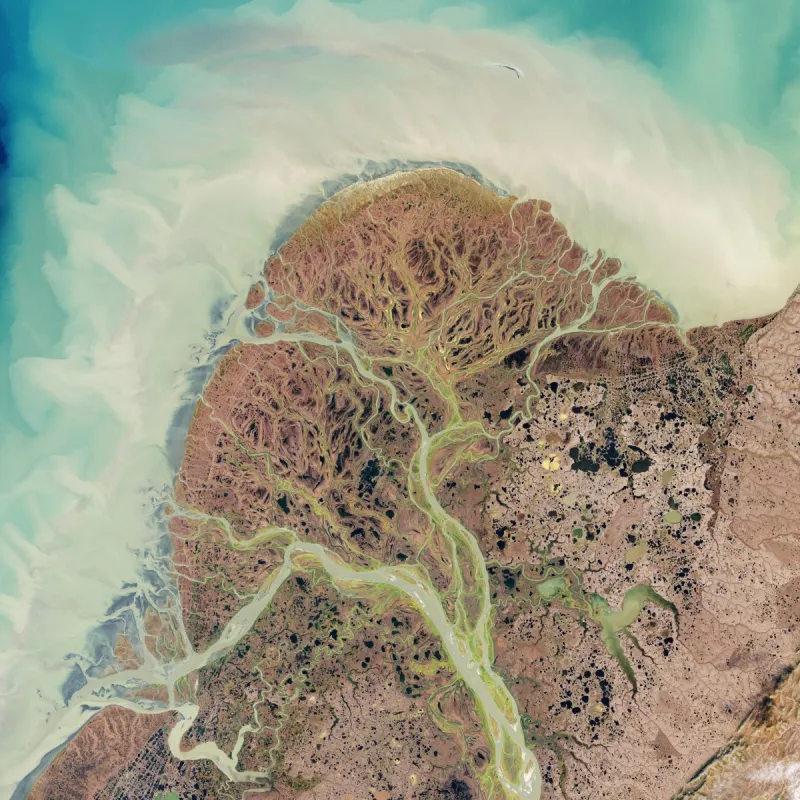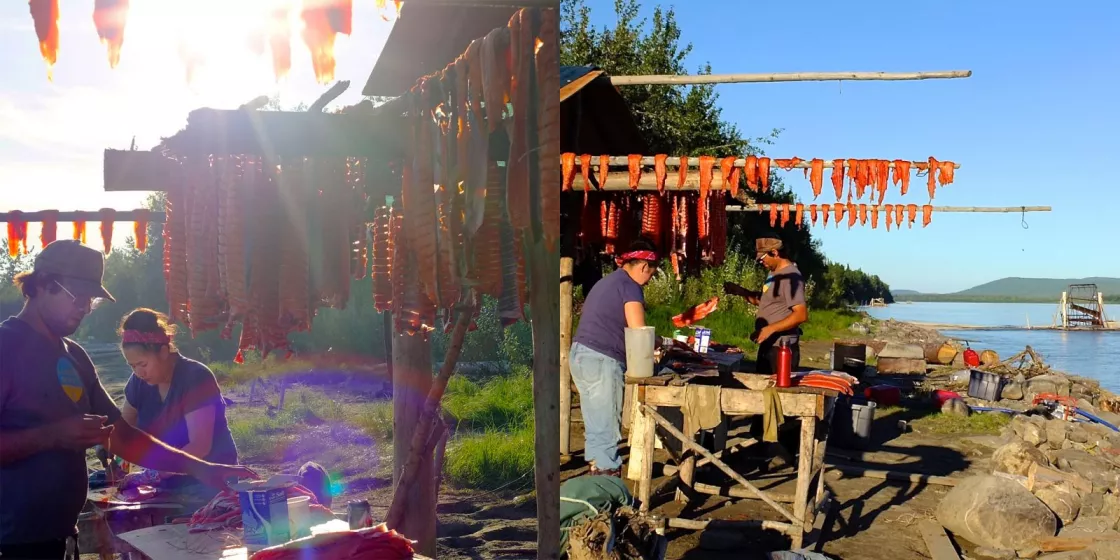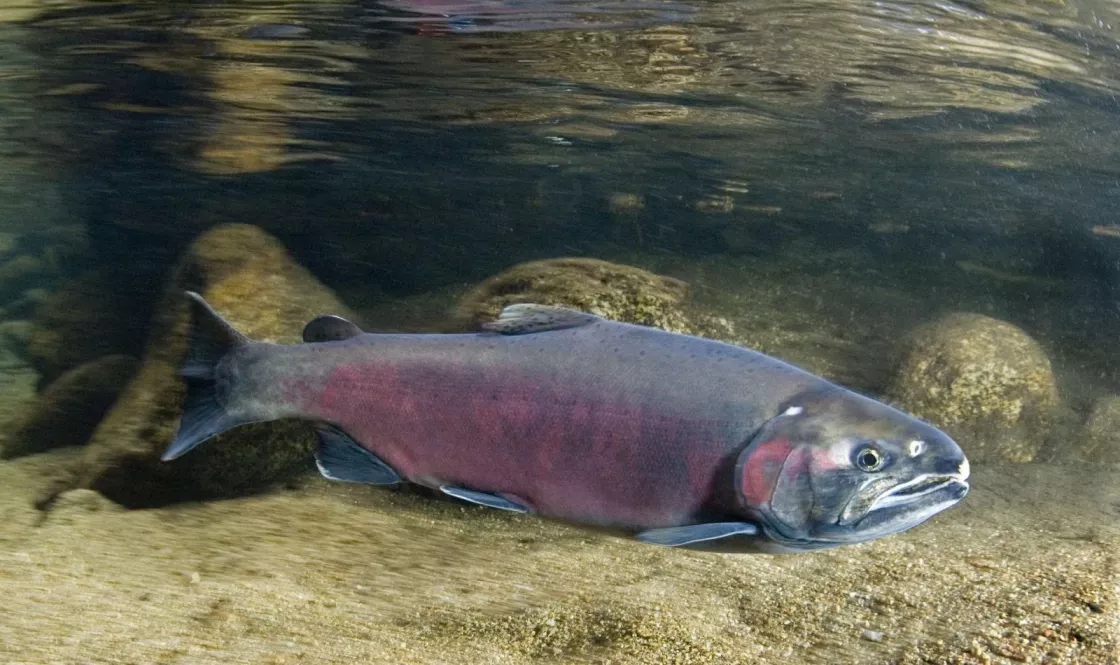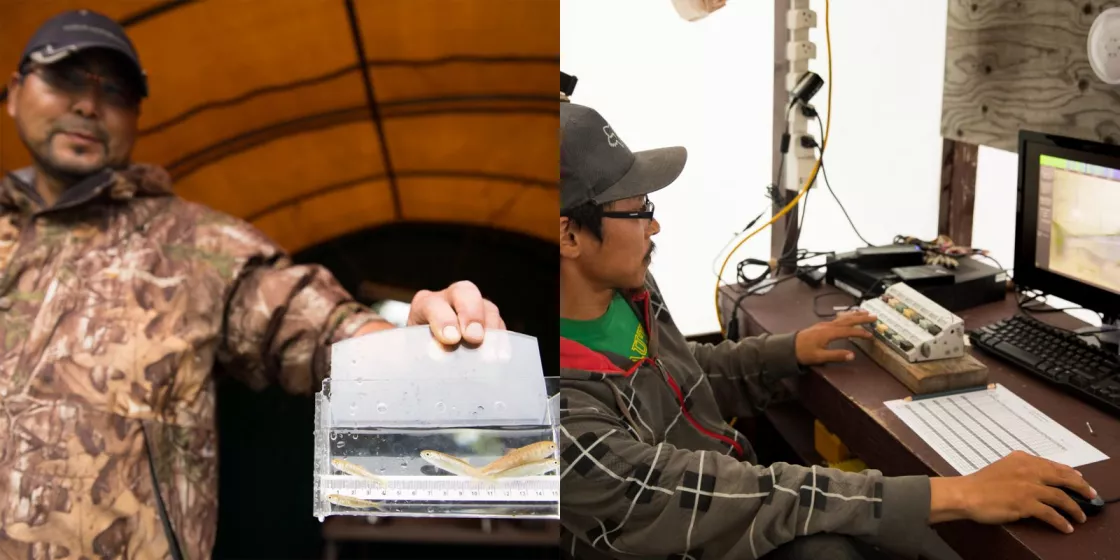By Agnieszka Gautier
When Yupik fishermen told Phil Mundy, a young biologist at the time, that the wind blew the salmon into the Yukon River, his Western science mind imagined a literal interpretation. “Perhaps they put their dorsal fins above the water and get a ride from the wind,” he thought. Now retired, he laughs at that idea.
The Yukon River, nearly 3,200 kilometers (2,000 miles) long, spreads from the Bering Sea like spider veins into the interior of Alaska and northwestern Canada. In late spring and early summer, Chinook salmon—commonly known as King salmon for their immense size and rich, oily meat—take on this river in one of the world’s greatest migrations and longest salmon runs. And they do it twice: born in freshwater, they swim out to sea to feed and grow for three to five years, only to return as plump adults to spawn, guard their eggs, and die.
The villages dotting the Yukon rely on these salmon for subsistence and commercial fisheries, and the fish play a big part in their culture and heritage. Mistakes in harvesting decisions, such as whether to open or close a fishery, could mean people upstream go hungry or the salmon population struggles to recover. “It’s very stressful to be in charge of the economic welfare of a few thousand miles of river. It is even more stressful without good information,” Mundy said.
Traditional Knowledge has held that spring weather conditions related to sea ice, temperatures, and wind signal the beginning of the Chinook salmon migration. In 1980, the Alaska Department of Fish and Game hired Mundy to refine the date of Chinook arrival at the test fishery location near Emmonak, Alaska, on the lower Yukon. To do so, Mundy needed to use environmental factors because of their influence on the timing of the Chinook salmon run. Over the course of his investigation, from 1980 to 2010, the sea ice concentration data from the National Snow and Ice Data Center (NSIDC) would turn out to be one of the most important elements of his forecasting model.
Balancing imbalance
The journey to create an accurate model of Alaska’s Chinook Salmon arrival was as long the Yukon River itself. Mundy wanted to predict the date when 50 percent of the total run had entered the river. Since 1961, that date has almost always been on June 21, but varies from June 10 to July 2 because the bulk of the fish, 40 to 45 percent, cross the delta within a 7-day period, straddling the 50 percent date.
To understand Yukon River Chinook salmon behavior, Mundy looked to his experience over the skies of many coastal salmon fisheries. “From aerial observations,” he said, “we knew salmon didn’t swim straight from the sea into the river.” Large schools swam right up the mouth of the river, but not into it, sometimes holding there for weeks at a time. This baffled Mundy. Why would they do that?
A saltwater fish placed abruptly into freshwater will die, and vice versa. Yet salmon undergo this physiological transformation twice in their lives, balancing salt concentrations in and out of their bodies. “This transformation is akin to that of a caterpillar turning into a butterfly. It is a profound physiological transformation,” Mundy said. To prepare for life in the salty ocean, young salmon drink lots of water, drop urine production, and the molecular pumps in their gill cells shift into reverse, pumping sodium out instead of in. All these physiological changes must be undone when the mature fish are ready to find their way back up the river.
Opportunity knocks
Mature salmon acclimate to freshwater by weaving across the temperature-salinity gradient that forms where the Yukon River meets the Bering Sea. To allow for this complex physiological transformation, salmon must also have the behavioral instincts to keep from charging into the river before their bodies are ready. Flying above the Alaskan coastline, Mundy saw another critical detail: a salt front, a wall where the massive input of freshwater from the salmon spawning rivers met the sea. This migration barrier forms when differences in salt concentration and temperature butt up against one another. “If the wind is not blowing too hard, it’s easy to identify the barrier,” Mundy said, “because these waters don’t mix.”
Seeing the clear demarcation between salt and freshwater led Mundy to his hypothesis: the stability of the temperature-salinity front at the mouth of the Yukon River was directly responsible for the speed with which the fish would enter the river. “If the line was well defined, virtually forming a wall, this would slow the fish down,” Mundy said. “If the waters around the mouth of the river swirled with the winds and current, then the fish would enter the river faster.”
Eddies, or circling pools of water, peel off into the northern Bering Sea when the temperature-salinity barrier breaks down. These swirling waters expose the salmon to more freshwater, thus allowing them to acclimate faster and enter the river earlier. Mundy’s next challenge was to figure out which variables influence this mixing.
The outlook
Following his aerial observations and conversations with Yupik fishermen and Traditional Knowledge holders in the 1980s, it was not until 2006 that Mundy was able to gather the environmental factors for his model: sea ice concentration data from the NSIDC Sea Ice Index, sea surface temperature data from the National Centers of Environmental Predication (NCEP), and air temperature and wind data from the National Oceanic and Atmospheric Administration (NOAA). When Bryce Mecum, currently managing the Yukon Chinook Run Timing project, joined the team in 2013, he verified through statistical analysis that these physical variables, which Mundy had hypothesized altering the salmon’s behavior, were indeed correlated to the run time. “It may look like a grab bag of data points, but it’s not,” said Mecum.
Of all the environmental factors considered, Mecum determined that sea ice was one of the strongest predictors of the salmon run. When ice is present and strongly packed, then wind cannot mix the water. “The river enters the Bering Sea like running a garden hose into the pool. There is no mixing,” Mundy said. “But ice alone cannot give you as good a picture as all together. These environmental factors all worked together.”
Mundy put together his forecasting model in 2011, but it did not become operational until 2012. Since then, Mecum noted that the actual halfway point has often fallen within two days of their prediction, though some years it has been off by up to five days. The most accurate predictions include years with shore-fast ice. These cold years often see a halfway point later than June 21. When it is warmer and there is little to no ice, the run becomes highly variable because there is no ice to control the mixing.
Sea ice loses ground
As the Arctic warms at twice the pace as the rest of the planet, sea ice is less dependable. Over the last two years, the Bering Sea has had little to no spring ice in certain parts. “Now we have been able to confirm another hypothesis,” Mundy said. “Once the ice is no longer the dominant factor determining the timing of the run, then the run will become much more variable. At that point it really will be the wind blowing the fish into the river. The whole system will be at the mercy of the wind. And we’re starting to see that.”
Since the mid 1990s, Chinook numbers plummeted from nearly 300,000 to an annual average of 100,000. In 2014, when numbers dropped to 64,000, the Alaska Department of Fish and Game made the painful decision to close the Yukon Chinook fishery for the entire summer.
The exact cause of the decline is still under scrutiny. It could be a combination of sea ice loss leading to young salmon arriving at the estuary too early, marine bycatch in the pollock commercial fishery, over or underfishing, or changes in critical environmental factors associated with global warming. The goal is to keep on top of the environmental and fishery observations.
“As the ice disappears, the fisheries are going to be much more difficult to manage,” Mundy said. “And the consequence will be that managers will be reluctant to let people fish at the lower part of the river because it’s too risky. All the people up the river have a lot at stake here. That’s the human impact.”
Phil Mundy retired on January 1, 2018 as the director of the NOAA Auke Bay Laboratories, a division of the Alaska Fisheries Science Center within the National Marine Fisheries Service.
For more information
The 2019 Run Timing Outlook and Forecast Summary
Mundy, P. R. and D. F. Evenson. 2011. Environmental controls of phenology of high-latitude Chinook salmon populations of the Yukon River, North America, with application to fishery management. ICES Journal of Marine Science. April 2012, 68, 1155-1164. doi:10.1093/icesjms/fsr080.
